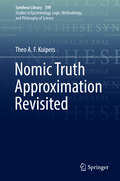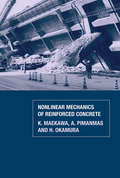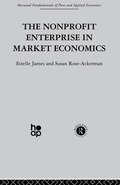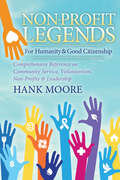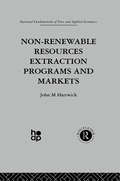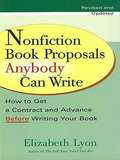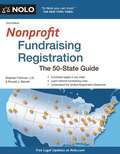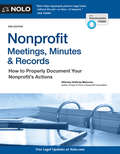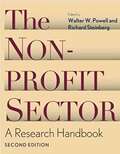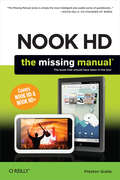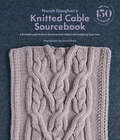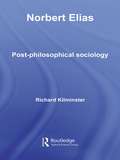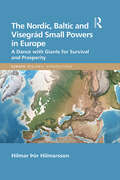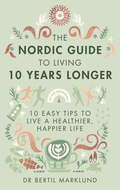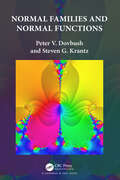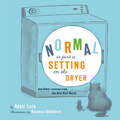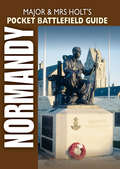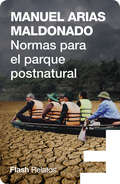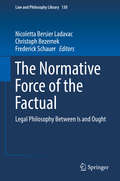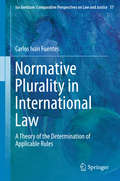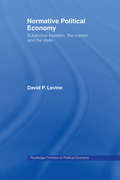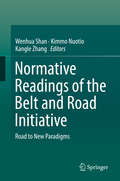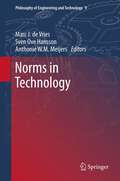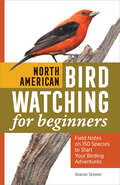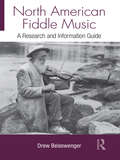- Table View
- List View
Nomic Truth Approximation Revisited (Synthese Library #399)
by Theo A. KuipersThis monograph presents new ideas in nomic truth approximation. It features original and revised papers from a (formal) philosopher of science who has studied the concept for more than 35 years.Over the course of time, the author's initial ideas evolved. He discovered a way to generalize his first theory of nomic truth approximation, viz. by dropping an unnecessarily strong assumption. In particular, he first believed to have to assume that theories were maximally specific in the sense that they did not only exclude certain conceptual possibilities, but also that all non-excluded possibilities were in fact claimed to be nomically possible.Now, he argues that the exclusion claim alone, or for that matter the inclusion claim alone, is sufficient to motivate the formal definition of being closer to the nomic truth. The papers collected here detail this generalized view of nomic truthlikeness or verisimilitude.Besides this, the book presents, in adapted form, the relation with several other topics, such as, domain revision, aesthetic progress, abduction, inference to the best explanation, pragmatic aspects, probabilistic methods, belief revision and epistemological positions, notably constructive realism.Overall, the volume presents profound insight into nomic truth approximation. This idea seeks to determine how one theory can be closer to, or more similar to, the truth about what is nomically, e.g. physically, chemically, biologically, possible than another theory. As a result, it represents the ultimate goal of theory oriented empirical science.Theo Kuipers is the author of Studies in Inductive Probability and Rational Expectation (1978), From Instrumentalism to Constructive Realism (2000) and Structures in Science (2001). He is the volume-editor of the Handbook on General Philosophy of Science (2007).In 2005 there appeared two volumes of Essays in Debate with Theo Kuipers, entitled Confirmation, Empirical Progress, and Truth Approximation and Cognitive Structures in Scientific Inquiry.
Non-Linear Mechanics of Reinforced Concrete
by K. Maekawa H. Okamura A. PimanmasThis book describes the application of nonlinear static and dynamic analysis for the design, maintenance and seismic strengthening of reinforced concrete structures. The latest structural and RC constitutive modelling techniques are described in detail, with particular attention given to multi-dimensional cracking and damage assessment, and their p
The Non-profit Enterprise in Market Economics (Fundamentals Of Pure And Applied Economics Ser. #Vol. 9)
by E. James S. Rose-AckermanAnalyses the behaviour of not-for-profit organizations under a variety of conditions and contrasts them with profit maximizing firms, other types of profit-constrained firms and with public bureaucracies.
Non-Profit Legends for Humanity & Good Citizenship: Comprehensive Reference on Community Service, Volunteerism, Non-Profits & Leadership
by Hank MooreNon-Profit Legends is a comprehensive overview book on serving communities and motivating leadership for non-profits. Author Hank Moore has worked with and advised hundreds of non-profit organizations, including charities, educational institutions, public sector entities, associations, and corporate citizenship programs. In Non-Profit Legends Hank uses his experience and teaches readers to embrace the past, with direct relationship to the future. Inside you will find extensive information about history, cultural enlightenment and community leadership knowledge, all rolled in one, plus a dynamic panorama of humanitarian contributions to society. Hank Moore is the highest level of business overview expert and is in that rarified circle of visionaries such as Peter Drucker, Stephen Covey and W. Edwards Deming. The Business Tree™ is his trademarked approach to growing, strengthening and evolving business, while mastering change. He advises companies about growth strategies, visioning, planning, leadership, futurism and Big Picture issues. He has written a series of business books. This is the third book in his Legends series, paralleling pop culture, history and innovative strategies. He has won lifetime achievement awards for leadership. Hank Moore’s Legends books embrace history, cultural phenomena and strategies for success.
Non-Renewable Resources Extraction Programs and Markets: Extraction Programs And Markets (Fundamentals Of Pure And Applied Economics Ser. #Vol. 3)
by J. HartwickConsiders the role of economics in discussions about the depletion of finite stocks of natural resources including oil.
Nonfiction Book Proposals Anybody can Write (Revised and Updated)
by Elizabeth LyonSign the contract...then write the book. The good news is that almost every nonfiction book published is sold by a proposal. In this comprehensive yet accessible guide, you will learn exactly what a proposal is, what it must contain, and how to pull yours together into an informative, persuasive selling package. Already a favorite for thousands of aspiring writers, this book has been revised and updated by Elizabeth Lyon to feature nearly two dozen actual proposals, plus: · Choosing a topic based on current trends and competing titles · Drafting the perfect concept statement--daring agents and editors to reject you · Defining and targeting your readership--then connecting with them · Preparing a table of contents and chapter summaries · Submitting exciting and well-written sample chapters · Writing query letters · Devising a marketing plan that will excite agents and publishers ·...
Nonprofit Fundraising Registration
by Stephen FishmanRaise money for your nonprofit without IRS trouble! Your nonprofit needs financial support, which means that you're most likely dependent on the kindness of donors to fill your coffers. If your nonprofit plans to solicit funds from out-of-state donors by phone, letter, email, on the web, or in any other manner, it's essential to fill out IRS Form 990 so that your organization stays legal. Nonprofit Fundraising Registration is your 50-state guide to the complex and varied registration requirements you'll need to meet while fundraising for your nonprofit. Learn how to keep your 501(c)(3) status when you're collecting cash, including: . exemptions from registration . how to register in different states . initial and annual filing requirements . rules for professional fundraisers . other crucial information your organization needs to legally fundraise outside of your home state You can't afford to overlook registration requirements -- use Nonprofit Fundraising Registration, your plain-English guide, to keep your nonprofit status in the eyes of the IRS. Plus, get the background information you need and get a line-by-line tutorial for the Unified Registration Statement, contact information for each state, and instructions on filing requirements for each state.
Nonprofit Meetings, Minutes & Records: How To Run Your Nonprofit Corporation So You Don't Run Into Trouble
by Anthony MancusoNonprofit? Stay out of IRS trouble with the ultimate corporate housekeeping tool! Nearly 1.5 million nonprofit organizations are busy preserving historic sites, saving libraries, helping the homeless, greening our cities--and so much more. Yet, while some have sophisticated record-keeping systems, most nonprofits are staffed by volunteers who need help running the organization and keeping up a proper--and legal--paper trail. Help has arrived! With Nonprofit Meetings, Minutes & Records, you'll get the all-in-one solution every nonprofiteer needs to hold meetings and document actions taken by board members. Step by step, it walks readers through: calling meetings appointing officers taking minutes making resolutions voting on proposals adjourning meetings working with a lawyer, if necessary, and finding a tax adviser. Nonprofit Meetings, Minutes & Records also provides useful tips and advice on how to do important tasks, such as organizing records, preparing meeting folders, and taking minutes. Plus, all necessary legal documents are included for you to fill out. It's everything you need to keep your nonprofit running smoothly and legally.
The Nonprofit Sector
by Göran Sonnevi Rosanna Warren Rika LesserThe second edition of The Nonprofit Sector provides a novel, comprehensive, cross-disciplinary perspective on nonprofit organizations and their role and function in society. This new, updated edition keeps pace with industry trends and advances as well as with the changing interests and needs of students, practitioners, and researchers. As before, every chapter has been written to stand on its own, providing sufficient background for the reader to follow the argument without referring to other chapters—allowing readers to selectively choose those chapters that are most relevant to a particular course, interest, or issue. <p><p>The Nonprofit Sector: A Research Handbook includes twenty-seven new or updated chapters. Relevant chapters from the previous edition have been refined, and new chapters have been added to fill in gaps, making this the authoritative reference for all who want an accessible, perceptive, and all-inclusive rendering of the nonprofit sector. The contributors—prominent scholars in their respective fields—carefully reflect upon the variety of changes in the rapidly growing world of nonprofits, examining a wide array of organizations, international issues, social science theories, and philanthropic traditions and covering a broad range of topics including the history and scope of nonprofit activities in the United States and abroad, the relation of nonprofits to the marketplace, government-nonprofit issues, key activities of nonprofits, aspects of giving to and joining nonprofits, and nonprofit mission and governance. <p><p>For anyone who wishes to have a deeper understanding of the nonprofit sector, this remains the essential guide.
NOOK HD: The Missing Manual
by Preston GrallaYou can do many things with NOOK HD right out of the box, but if you really want to get the most from your HD or HD+ tablet, start with this book. With clear instructions, full-color illustrations, and savvy advice from technology expert Preston Gralla, you’ll learn how to use email and the Web, watch movies and shows, play games, listen to music, and enjoy your personal ebook library.The important stuff you need to know:Relax with a book. Load your NOOK library with ebooks, comics, and interactive books for kids.Play with apps. Enjoy the games and apps everyone’s talking about.Go online. Browse the Web and check your email with built-in WiFi.Be social. Share books and recommendations with your NOOK Friends, and Facebook and Twitter contacts.Take in a show. Watch movies and TV series, and listen to your favorite music anywhere.Read all about it. Subscribe to a variety of magazines and newspapers.
Norah Gaughan's Knitted Cable Sourcebook: A Breakthrough Guide to Knitting with Cables and Designing Your Own
by Norah GaughanA groundbreaking stitch dictionary from a cable master, featuring 150 cable stitch patterns and fifteen garment patterns to test your skills.This guide for the modern knitter presents more than 150 new and innovative cable stitch patterns ranging from basic to complex and offers enlightening insight into how cables are engineered, how knitters can design their own, and how knitters can mix and match cables in a knitting pattern. Teacher, author, and master knitter Norah Gaughan shares her design principles and offers clear cable-making instruction throughout, always in a conversational, easy-to-understand voice that proceeds naturally, as one cable idea leads to the next. Master the art of cable knitting, then test your newfound skills with the fifteen garment patterns for wraps, sweaters, and accessories.
Norbert Elias: Post-philosophical Sociology
by Richard KilminsterFew sociologists of the first rank have scandalised the academic world to the extent that Elias did. Developed out of the German sociology of knowledge in the 1920s, Elias’s sociology contains a sweeping radicalism which declares an academic ‘war on all your houses’. His sociology of the ‘human condition’ sweeps aside the contemporary focus on ‘modernity’ and rejects most of the paradigms of sociology as one-sided, economistic, teleological, individualistic and/or rationalistic. As sociologists, Elias also asks us to distance ourselves from mainstream psychology, history and above all, philosophy, which is summarily abandoned, although carried forward on a higher level. This enlightening book written by a close friend and pupil of Elias, is the first book to explain the refractory, uncomfortable, side of Elias’s sociological radicalism and to brace us for its implications. It is also the first in-depth analysis of Elias’s last work The Symbol Theory in the light of selected contemporary developments in archaeology, anthropology and evolutionary theory.
The Nordic, Baltic and Visegrád Small Powers in Europe: A Dance with Giants for Survival and Prosperity (Europa Regional Perspectives)
by Hilmar Þór HilmarssonThis volume addresses and seeks to answer a number of questions on the current issues facing small states/powers in Europe. How can small European states survive and prosper within a multipolar world of great powers? What part should small states take in European integration? Are EU fiscal and monetary policies allowing for Keynesian economic stimulus when needed and are euro area convergence criteria viable as the world recovers from the COVID-19 crisis? Are small state alliances within the EU useful to counterbalance the influence of the larger EU member states? How far should EU and NATO expansion go? Should it include countries such as Ukraine? Can the EU rely on US leadership of NATO for its security? How should small states relate to great powers seeking to influence Europe, most notably the US, the People’s Republic of China and the Russian Federation? Do smaller states need to choose a single ally among the major powers? Using an interdisciplinary approach, the author discusses issues of economic policy, international relations and politics, economic and political integration, as well as the effects of global and regional institutions, and priorities in bilateral development cooperation, demonstrating how policies are shaped by the interaction between small states (small powers) and large states (great powers).
The Nordic Guide to Living 10 Years Longer: 10 Easy Tips to Live a Healthier, Happier Life
by Dr. Bertil MarklundThe Danes may have their hygge and the Norwegians their back to the land culture, but the Swedes have 'lagom': an even-keeled approach to a life of balance.Dr Bertil Marklund - a doctor and researcher at the Gothenburg University with over forty years of experience - provides the most cutting-edge research to explain the ten areas we should focus on to better our chances of a long life.This compact guide provides wisdom from the Nordics, a region long known for its healthy and progressive lifestyle. It debunks myths on things we have been told are not good for us but actually can be: did you know drinking coffee will promote your health? Or that more people die of lack of Vitamin D than they do of skin cancer? By providing pragmatic and realistic advice, Dr Marklund gives you the power to make a difference in your own life today and for the future.
Normal Families and Normal Functions
by Peter V. Dovbush Steven G. KrantzThis book centers on normal families of holomorphic and meromorphic functions and also normal functions. The authors treat one complex variable, several complex variables, and infinitely many complex variables (i.e., Hilbert space).The theory of normal families is more than 100 years old. It has played a seminal role in the function theory of complex variables. It was used in the first rigorous proof of the Riemann mapping theorem. It is used to study automorphism groups of domains, geometric analysis, and partial differential equations.The theory of normal families led to the idea, in 1957, of normal functions as developed by Lehto and Virtanen. This is the natural class of functions for treating the Lindelof principle. The latter is a key idea in the boundary behavior of holomorphic functions.This book treats normal families, normal functions, the Lindelof principle, and other related ideas. Both the analytic and the geometric approaches to the subject area are offered. The authors include many incisive examples.The book could be used as the text for a graduate research seminar. It would also be useful reading for established researchers and for budding complex analysts.
Normal Is Just a Setting on the Dryer: And Other Lessons from the Real Real World
by Adair LaraWhen the self-help books just aren’t helping, it’s time to call in the experts: real people . . . San Francisco Chronicle columnist Adair Lara polled her readers for life lessons learned through experience, receiving thousands of heartfelt and irreverent responses. The best are compiled here in more than two hundred bits of priceless counsel, accompanied by witty, whimsical illustrations by award-winning artist Roxanna Bikadoroff. This handy little volume is filled with humor, unconventional insights, and the kind of common wisdom that will always bear repeating.
Normandy: Normandy Landing Beaches (Major & Mrs Holt's Pocket Battlefield Guide)
by Tonie Holt Valmai HoltA compact traveler&’s guide to the French region&’s World War II historical sites, featuring planned itineraries of places to see and where to go. This guidebook covers the present-day battlefield and the actions that took place on and immediately behind the D-Day beaches, and Major and Mrs. Holt's Pocket Battlefield Guide to Normandy has been put together to take you around the area. This book is part of a new series of guides designed conveniently in a small size for those who have only limited time to visit, or who are simply interested in as an introduction to the historic battlefields, whether on the ground or from an armchair. They contain selections from the Holts&’ more detailed guide of the most popular and accessible sites plus handy tourist information, capturing the essential features of the Battles. The book contains many full color maps and photographs and detailed instructions on what to see and where to visit.
Normas para el parque posnatural
by Manuel Arias MaldonadoUna reflexión sobre la relación entre la sociedad y la naturaleza en el contexto del cambio climático. En este ensayo, Manuel Arias Maldonado reflexiona sobre implicaciones filosóficas y morales relacionadas con el cambio climático. ¿Podemos conseguir frenarlo sin alterar los límites de las libertades individuales? ¿Es posible volver al período anterior al Antropoceno? ¿Hasta qué punto son compatibles los principios para preservar la naturaleza con las sociedades liberales? A través de estas preguntas, el autor plantea la necesidad de problematizar conceptos como democracia o esfera privada, con tal de garantizar la supervivencia de la especie. Ya que, tal como él mismo afirma, «cuidar del entorno natural es cuidar de la libertad de los ciudadanos del futuro.»
The Normative Force of the Factual: Legal Philosophy Between Is and Ought (Law and Philosophy Library #130)
by Nicoletta Bersier Ladavac Christoph Bezemek Frederick SchauerThis book explores the interrelation of facts and norms. How does law originate in the first place? What lies at the roots of this phenomenon? How is it preserved? And how does it come to an end? Questions like these led Georg Jellinek to speak of the “normative force of the factual” in the early 20th century, emphasizing the human tendency to infer rules from recurring events, and to perceive a certain practice not only as a fact but as a norm; a norm which not only allows us to distinguish regularity from irregularity, but at the same time, to treat deviances as transgressions. Today, Jellinek’s concept still provides astonishing insights on the dichotomy of “is” and “ought to be”, the emergence of the normative, the efficacy and the defeasibility of (legal) norms, and the distinct character of what legal theorists refer to as “normativity”. It leads us back to early legal history, it connects anthropology and legal theory, and it demonstrates the interdependence of law and the social sciences. In short: it invites us to fundamentally reassess the interrelation of facts and norms from various perspectives. The contributing authors to this volume have accepted that invitation.
Normative Plurality in International Law
by Carlos Iván FuentesThis book provides a theoretical framework for explaining the choices made by international decision-makers in terms of what constitutes law. It comprehensively analyzes the practice of human rights courts in applying legal instruments outside their competence and proposes that this practice recognizes that different normative instruments coexist in an un-ordered space, and that meaning can be produced by the free interaction of those instruments around a problem. Based on this, the book advances its normative plurality hypothesis, which states that decision-makers must survey the acquis of international law in order to identify all the instruments containing relevant normative information for a particular situation. The set of rules of law applicable to the situation must then be complemented with other instruments containing specific normative information relevant to the situation, resulting in a complete system of norms advancing a common purpose.
Normative Political Economy: Subjective Freedom, the Market and the State (Routledge Frontiers Of Political Economy Ser.)
by David P. LevineNormative Political Economy explores the criteria we use for judging economic institutions and economic policy. It argues that prevailing criteria lack sufficient depth in their understanding of subjective experience. David Levine's arguments cover topics which include: * basic needs, equality and justice * freedom, self-integration and creative living * the role of the state * capitalism and the good society
Normative Readings of the Belt and Road Initiative: Road To New Paradigms
by Wenhua Shan Kimmo Nuotio Kangle ZhangThis timely book offers revealing insights into the changing role of China in world governance as exemplified by the Silk Road Initiative, the People’s Republic’s first published major initiative for external affairs. Focusing on various aspects of the Silk Road Initiative, particularly those that are largely neglected in current discussions, including culture and philosophy, finance and investment, environmental protection and social responsibility, judiciary and lawyers, the authors explore a wide range of contexts in which China’s role as an emerging power in international relations and international law is examined. In the current era of ever-increasing populism, protectionism and challenges to globalization, the authors explore the Chinese philosophy underpinning Chinese norms of regional and international development. Bearing in mind the political and economic uncertainties hampering the establishment of such norms, the authors offer crucial insights into how the Silk Road Initiative could or should be developed and regulated.Given its depth of coverage, the book is an indispensable read for anyone interested in the Initiative and its social-legal implications.
Norms in Technology
by Sven Ove Hansson Anthonie W.M. Meijers Marc J VriesThis book is a distinctive fusion of philosophy and technology, delineating the normative landscape that informs today's technologies and tomorrow's inventions. The authors examine what we deem to be the internal norms that govern our ever-expanding technical universe. Recognizing that developments in technology and engineering literally create our human future, transforming existing knowledge into tomorrow's tools and infrastructure, they chart the normative criteria we use to evaluate novel technological artifacts: how, for example, do we judge a 'good' from a 'bad' expert system or nuclear power plant? As well as these 'functional' norms, and the norms that guide technological knowledge and reasoning, the book examines commonly agreed benchmarks in safety and risk reduction, which play a pivotal role in engineering practice. Informed by the core insight that, in technology and engineering, factual knowledge relating, for example, to the properties of materials or the load-bearing characteristics of differing construction designs is not enough, this analysis follows the often unseen foundations upon which technologies rest--the norms that guide the creative forces shaping the technical landscape to come. The book, a comprehensive survey of these emerging topics in the philosophy of technology, clarifies the role these norms (epistemological, functional, and risk-assessing) play in technological innovation, and the consequences they have for our understanding of technological knowledge.
North American Bird Watching for Beginners: Field Notes on 150 Species to Start Your Birding Adventures
by Sharon StitelerLearn how to identify 150 North American birds—your new summer hobbyFrom the tiny ruby-throated hummingbird to the powerful bald eagle, there's a fascinating variety of unique and beautiful birds that call North America home. This compact field guide is the perfect introduction to birding. You'll find essential information about 150 North American species and expert advice on how to get started on your bird-watching journey.Dive into the perfect summer activity with:The basics of bird watching—Learn important birding terminology, what equipment to have on hand, and how to log and submit your bird sightings.Complete bird profiles—Discover full-color photos and need-to-know details about each species' appearance, behavior, and population range.Easy-to-find information—This book's simple organization makes it the ideal companion for your bird watching adventures, with clearly marked sections for common backyard birds, songbirds, shorebirds and waterbirds, and raptors.Get to know your feathered neighbors this summer with this field guide to the birds of North America.
North American Fiddle Music: A Research and Information Guide (Routledge Music Bibliographies)
by Drew BeisswengerNorth American Fiddle Music: A Research and Information Guide is the first large-scale annotated bibliography and research guide on the fiddle traditions of the United States and Canada. These countries, both of which have large immigrant populations as well as Native populations, have maintained fiddle traditions that, while sometimes faithful to old-world or Native styles, often feature blended elements from various traditions. Therefore, researchers of the fiddle traditions in these two countries can not only explore elements of fiddling practices drawn from various regions of the world, but also look at how different fiddle traditions can interact and change. In addition to including short essays and listings of resources about the full range of fiddle traditions in those two countries, it also discusses selected resources about fiddle traditions in other countries that have influenced the traditions in the United States and Canada.
